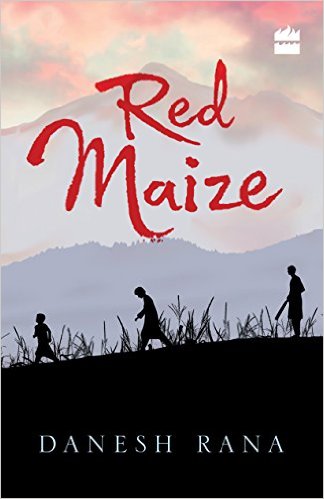"Red Maize": Fiction Rooted In Truth
Book Review By Haleem Qarrar
18 January, 2016
Countercurrents.org
AUTHOR: DANESH RANA (IPS)
PUBLISHER: HARPER COLLINS
 Among the many one liners that the 2005 anarchism inspired dystopian movie V for Vendetta is famous for, I love quoting this one: “Artists use lies to tell the truth”. Red Maize is fiction but not lies. The plot is all too true, clichéd and subtly balanced. Where then, one may ask, lays the merit in Red Maize? Red Maize is a book brimming with brave decisions. The author’s brave decision to choose the plot he has, the decision of revisiting the uncomfortable truths for all three sides involved in the plot – (the common people, the militants, the forces) and last but not the least the decision to represent the magnitude of human tragedy on all three sides. Thus that makes it different from other well known fiction books about the conflict.
Among the many one liners that the 2005 anarchism inspired dystopian movie V for Vendetta is famous for, I love quoting this one: “Artists use lies to tell the truth”. Red Maize is fiction but not lies. The plot is all too true, clichéd and subtly balanced. Where then, one may ask, lays the merit in Red Maize? Red Maize is a book brimming with brave decisions. The author’s brave decision to choose the plot he has, the decision of revisiting the uncomfortable truths for all three sides involved in the plot – (the common people, the militants, the forces) and last but not the least the decision to represent the magnitude of human tragedy on all three sides. Thus that makes it different from other well known fiction books about the conflict.
Red Maize is set in a nondescript village – Morha Madana whose geographical location is clear to the extent that it lies close to the Chenab river and the Doda town. It’s a gut wrenching tale about a widow who loses all three sons to the conflict. Set in the period of late 90s the plot beautifully portrays the Kashmir conflict spilling over into the adjoining regions and the human tragedy associated with it thereof. Kausar Jan is a widow whose second son, Shakeel, has chosen to traverse the path of militancy drawing them into a quagmire of brutalization and intrigue. Shakeel is hounded by the army especially Major Rathore, the swanky army man in his late twenties who likes listening to Pink Floyd and dreams of getting back to his home city of Jaipur where he can marry and go shopping in malls. While as Shakeel is killed by the security forces, the elder brother Khalid (who paradoxically had always been against Shakeel and his ideology) after being brutalized for being a militant’s brother is forced to take up the gun himself and disappears – probably buried in one of the many nameless graves . The youngest school going son Firdous is lured into becoming a policeman and is killed by intrigue after labeling him a deserter who tried to escape from the force to join militant ranks.
In between these characters there are others who play their part. The wily Gul Mohammad who loves money and tries to double cross both the army and militants only to be beheaded by Shakeel. Gul Mohammad’s elder daughter Hasina who ultimately manages to get Shakeel killed in revenge. Hasina’s younger sister Fauzia who is a victim of lust and is killed in a tragic way. Nilofer, Shakeel’s love and wife, who is left with a three month unborn child on his death.
Red maize succeeds in highlighting human emotions across the characters. Emotions of an aging mother who is faced with calamity after calamity. A mother who changes many descriptions- from being a militant’s mother to a half mother to a policeman’s mother to finally not being a mother at all. The author is successful in creating many moments where one feels a lump in ones throat. Be it the wily Gul Mohammad pissing in his pajamas on facing the imminent death or a brutalized Khalid wishing for his militant brother’s death and imagining cricket ball coloured blood oozing out of his brother’s body or Shakeel’s imagination connecting the colour of kehwa to the copper coloured rounds in his Kalashnikov.
The narrative is slow to pick up. The first chapter is marked by small sentences that give the impression of a reluctant start. But once the narrative picks up it is fairly fluid. There is another downside that the publishers could have done away with –small mistakes in using Urdu words that feel irritating and almost disrupt the flow of the narrative - fatiha is confused with janaza , ijab o qubool is called ijab e qubool , takhallus is called takhluz, asalamu alaikum is asalamwalekum. Strangely enough on the back cover there is almost a desperate insistence of the publishers to place the story in Kashmir, which is not technically correct. The word Kashmir appears thrice on the back cover almost the same number of times it appears in the full book. The book is not about Kashmir it is about the metastatic repercussions of the Kashmir conflict. The story is not set in Kashmir but nevertheless the emotions are universal.
The writer is based in Srinagar, Jammu and Kashmir and is B.Tech , M.A (Philosophy) with keen interest in Philosophy , Art , Literature and Culture . Having lived with the reality of Kashmir conflict throughout his life the writer has first hand experience of the things depicted in the Novel. email : [email protected]

